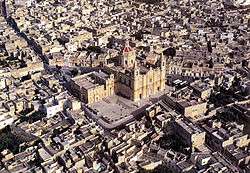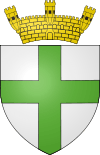Żejtun
| Żejtun Iż-Żejtun Città Beland, Casal Santa Catarina; Bisqallin; Casal Bisbut | |||
|---|---|---|---|
| City and Local council | |||
|
Aerial view of Żejtun with the parish church at the centre | |||
| |||
| Motto: Palladis clara munera | |||
 | |||
| Coordinates: 35°51′20″N 14°32′0″E / 35.85556°N 14.53333°ECoordinates: 35°51′20″N 14°32′0″E / 35.85556°N 14.53333°E | |||
| Country |
| ||
| Region | South Eastern Region | ||
| District | South Eastern District | ||
| Borders | Fgura, Għaxaq, Marsaskala, Marsaxlokk, Santa Luċija, Tarxien, Żabbar | ||
| Government | |||
| • Mayor | Joseph Attard (PL) | ||
| Area | |||
| • Total | 7.4 km2 (2.9 sq mi) | ||
| Elevation | 60 m (200 ft) | ||
| Population (March 2014) | |||
| • Total | 11,508 | ||
| • Density | 1,600/km2 (4,000/sq mi) | ||
| Demonym(s) | Żejtuni (m), Żejtunija (f), Żwieten (pl) | ||
| Time zone | CET (UTC+1) | ||
| • Summer (DST) | CEST (UTC+2) | ||
| Postal code | ZTN | ||
| Dialing code | 356 | ||
| ISO 3166 code | MT-67 | ||
| Patron saint | St. Catherine of Alexandria | ||
| Day of festa | Third week of June | ||
| Website | Official website | ||
Żejtun (Maltese: Iż-Żejtun [ɪzˈzɛjtʊn]) is a city in the South Eastern Region of Malta, with a population of 11,508 in March 2014.[1] Żejtun holds the title of Città Beland, which was bestowed by the grandmaster of the Order of the Knights of Malta, Ferdinand von Hompesch zu Bolheim, in 1797.
Żejtun's elder cores, Bisqallin and Ħal Bisbut, largely retain their narrow medieval streets and ancient boundaries. Since at least the 19th century, the name Żejtun has also referred to the larger city which developed around these two core villages. Together with a number of small hamlets in the vicinity, the bulk of this conurbation forms the city of Żejtun, administered by the mayor and the Żejtun Local Council. The city experienced extensive urbanisation over the seventies and eighties, with the completion of numerous infrastructural and urban projects designed to relieve housing congestion in the neighbouring Cottonera area.
Żejtun is a major city on the islands, giving a significant contribution to the islands' history, arts and commerce. One of the country's principal industrial estates, Bulebel, can be found on the city's borders.[2] Żejtun contains a number of important heritage sites, such as St Catherine's Parish Church, St Gregory's Church, numerous votive chapels, and the remains of a Roman villa. The parish of Żejtun is one of the oldest on the islands, and existed already in 1436. The original parish church was built in the twelfth century, and rebuilt in 1492.[3] The incumbent mayor is Joseph Attard. The archpriest is Fr Nicholas Pace.[4]
Toponymy
The etymology of Żejtun has been studied over the ages. It takes its name from the Sicilian Arabic for "olive" – zaytun (Arabic: الزيتون and cognate of the Spanish aceituna and Portuguese azeitona) – one of the main productive industries in Malta. This was confirmed by Ciantar, who stated that "the town was very pleasant, due to the great quantity of olive groves, from whence it got and still retains the name Zeitun, which means olive; there is also the tradition that olive oil in abundant quantity used to be made here."[n 1]
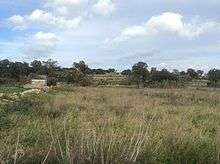
The Arabic origin of the town's name was again recorded in the first Maltese language dictionary as Żejtun, in the eastern part of the island of Malta, there is a large, rich and thriving town with this name, which incorporates another area called Bisqallin, and the village of Bisbut. In the Saracen era, there must have been olive groves here, for the area to retain its true name.[n 2]
Over the centuries, Żejtun was identified with several names. Iż-Żejtun, Ħal Bisbut, Ħal Ġwann, and Bisqallin were used interchangeably to refer to both specific areas or to the whole urban agglomeration. The name Bisqallin, which is the name of the lower part of the city, means "the sons of Sicily", derived from a number of Sicilian emigrants who inhabited this part of the island after having landed at Marsascala.[6] This name was further corrupted into the Italian Casal Pasqualino.[7] Żejtun shares its name with a number of settlements and areas in Greece, North Africa and the Near East. Today, Bisqallin (Biskallin)[8] is known as ir-raħal t'isfel, the 'lower village', while Ħal Bisbut is referred to as ir-raħal ta' fuq, the 'upper village.'
Topography
The core of Żejtun is located on a hill, at an altitude of 60 metres (197 feet) above sea level. This promontory is marked to the north by Wied iz-Ziju, which separates Żejtun from Tarxien and the outlying high ground. This valley is partly obscured by the Bulebel industrial zone, and an old road which connects Tarxien to Żejtun, as well as by the widened arterial road of Tal-Barrani.[9] The valley meanders until it reaches the harbour of Marsascala. To the south, the Żejtun promontory is bounded by a gentle slope which then forms the greater port area of Marsaxlokk. The higher ridge of Żejtun is marked by the late medieval chapel of Saint Catherine of Alexandria, known as Saint Gregory's Church, and the important crossroads of Bir id-Deheb.[10]
History
Prehistory and antiquity
.jpg)
Żejtun is strategically located between three important ancient harbours, that of Marsa to the north, and those of Marsaxlokk and Marsascala to the south. The area now identified as Żejtun was occupied since prehistoric antiquity. Late Neolithic remains were found near the megaliths of Ħal Ġinwi, as well as the megalithic remains at Tas-Silġ, found on a hillock between Żejtun and Marsaxlokk. These sites remained in use during the Bronze Age, as well as during later historical periods. Pottery shards possibly carrying the inscribed name of the Phoenician god Ashtart were also found.[11]
Along the southern edge of Żejtun, the construction of a school led to the discovery of an ancient Roman villa.[12] These remains still contain areas of the original Roman tiles and coloured stucco. The complex was an active settlement since the Bronze Age, although the presently visible remains can be mainly dated from the Punic period right up to Late Antiquity. More evidence of ancient habitation in the area comes from burial grounds, such as those around St Gregory's Church, Tal-Barrani, Tal-Ħotba and Bulebel.[12] The excavation site at the villa confirms the presence of a thriving olive oil industry on the southern end of the islands.[13] Modern historical studies and topology confirm that the area between Żejtun and Marsaxlokk was covered in vegetation and pasture land.[14]
Medieval Żejtun
With the collapse of Roman rule in the early 5th century, the Roman villa in Żejtun started a period of long decay. The Christian religion and Byzantine civilisation, however, clung on in the Tas-Silġ area, with the construction of a three-aisled basilica built atop pagan temples. The basilica, and a monastery nearby, remained in use until their definite demise following the Arab invasion of 870.[15]
Ibn Hawqal, writing about the invasion of 870, describes how the whole islands were depopulated, with modern scholars debating that the invasion marked an outright “ethnic break and not merely a cultural and religious switch on the Maltese islands.” [16] Little is known about Żejtun under Arab rule. Outside Mdina and possibly Birgu, hardly any village existed. However, a number of Late Medieval place-names in the general area of Żejtun, such as Bir id-Deheb, Ħajt il-Wied, Tal-Ħotba and Bulebel il-Kbir serve to highlight the intensity with which the area was used.[17] One such name, il-Minżel, in Bulebel iż-Żgħir, can be translated as 'the field at the descent' or the 'field at the house,' with the word manzil meaning a stopping place, a place of alighting, a settlement or abode.[17] A large number of place names confirms the accessibility of the land, and therefore its use. This land was extensively used, with the Arabs using the established agroindustrial infrastructure as the basis for their presence in Malta and Gozo.
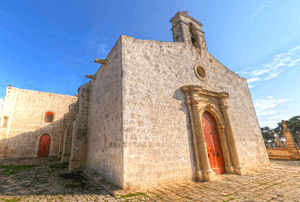
With the Norman occupation of 1091 and re-establishment of Latin rule in 1127, a slow re-Christianisation process began with monks from the monastery of Saint Basil arriving to Malta from Sicily and Pantelleria. These were devoted to various saints, particularly Saint George and Saint Catherine of Alexandria.[18] The devotion towards the latter led to the dedication of a number of chapels to the saint. One of these was the Church of Saint Catherine of Bisqallin, now known as Saint Gregory's church. This church was renowned across the islands for its age, being one of the first built in Malta following the end of Saracen rule.[19]
In 1223, Emperor Frederick II, ordered the exile of the entire male population of Celano to Sicily and Malta. An established tradition, held in both Żejtun and Celano, claims that some of these exiles settled down in Żejtun.[20][21][22]
The island's communal organisation in this period pitted the Mdina town-council, or Universitas, against the independent entity centred around the Castrum Maris. Many inhabitants of Birgu, and the neighbouring villages, argued that they were not liable to pay taxes to the Mdina town-council, as they fell within Castrum Maris jurisdiction. This was the case with the inhabitants of Żejtun, who refused to pay the taxes due to the Mdina council in 1473.[23] However, as late as 1494, in case of attack, the inhabitants of Żejtun were still expected to take shelter up at Mdina.[24] The villages' lack of defences, and proximity with the sea, made all casals in the south-east of Malta exposed to raids and incursions.
The chapel of St Catherine was already a parish church in 1436, and was the fifth of the eight mother churches on Malta.[19] This chapel stood halfway between Bisqallin and Ħal Bisbut, a distance of half a mile from each village. This medieval chapel remained in use until 1492, when it was rebuilt and enlarged to its present state. This was commemorated by an inscription.[n 3]
The present church was built on the footprint of the old chapel, with the current building's nave now corresponding with the old chapel walls. The chapel was enlarged in 1593 and again in 1603, with the additions of transepts and an altar. With the addition of these transepts, this was the first church in Malta to be given the form of a latin cross.[26]
Feast of Saint Gregory
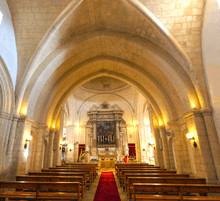
The feast of Saint Gregory was one of the principal traditional feasts on the islands, involving a procession composed of confraternities from all the parishes on the islands.[27] The origin of this feast was unknown for centuries, with the common belief that it related to a general vow by the populace on their deliverance from a great plague in 1519.[28] Recent studies have concluded that the procession was first held in 1543 by Bishop Cubelles, in response to a papal call for prayers for peace.[28] Originally the feast was held on March 12, later moving to Easter Wednesday.[3]
The procession included the respective clergy from all the islands' towns and villages, the canons of the Cathedral and the bishop, who assembled together - initially starting from Mdina, but later beginning at Raħal Ġdid,[27] or Tarxien,[3] thence walking to Żejtun. On their way, the whole company joined in the litany, as pronounced by the chief priest of each confraternity.[27] On their arrival at Żejtun, the procession visited the church of Saint Gregory, where at a particular point of the ceremony, the crowd exclaimed aloud for three times the word misericordia. The remaining part of the day was then spent in eating and feasting, and other kinds of amusements.[27]
For the past thirty years, the procession begins at the Chapel of Saint Clement, which is just over a kilometre away from the church of Saint Gregory. On the way, it enters the current parish-church of Żejtun, then continuing to Saint Gregory's. On arrival, a mass is celebrated by the Cathedral Chapter's dean, with the archbishop presiding the ceremony. Traditionally, after the ceremony, those in attendance go to the nearby harbour of Marsaxlokk for their first swim of the year. Traditional food stands and fairs are held throughout the day. Historically, it used to be an old custom for the new bridegrooms to take their spouses to this feast as part of their marriage contract.
Early modern
By 1575, the parish of Żejtun contained nineteen churches, seven in Żejtun, three in Ħal Għaxaq, five at Żabbar and four rural chapels. On July 6, 1614, a considerable Turkish force of sixty galleys laid anchor at Marsascala and St Thomas Bay. The Turks pillaged Żejtun, damaging the church of St Gregory's, and the surrounding villages. The attack continued until the Turkish pirates were forced back to their ships by the Maltese cavalry and militia. The leader of the Żejtun contingent, Clemente Tabone, built a chapel dedicated to St Clement, in commemoration of the deliverance from the attack.[29] This attack confirmed the need of the coastal towers of St Thomas and St Luciano, in Marsascala and Marsaxlokk respectively.[30] Increased population, and the extensive size of the parish led to an eventual reorganisation. On December 23, 1615, Bishop Baldassere Cagliares separated Żabbar from the parish of Żejtun, while Ħal Għaxaq was recognised as a parish on January 1, 1626.[31]
In 1637, Grandmaster Giovanni Paolo Lascaris ignored the Maltese clergy's protest lodged with Pope Urban VIII regarding taxation. The Pope sided with the Order against the laity and the clergy, and the Grandmaster set out to levy a tax of 50,000 scudi on the Maltese for the construction of the Floriana Lines.[34] The tax collectors met immediately with opposition, and an uprising began in September in Żejtun, the first village where collection was attempted.[35] The leaders hoped to assemble the people at Marsa, then to march on Valletta as a procession with a cross or some statue of a saint. The parish priest of Żejtun was alarmed at these preparations, particularly the suggestions to bear arms in the protest, and informed the Bishop, Miguel Juan Balaguer Camarasa.[35] The Bishop sent the priest to the inquisitor, Fabio Chigi, later Pope Alexander VII, who ordered him to report everything to the grandmaster who imprisoned the lay leaders of the revolt. Acting on Chigi's advice, the grandmaster did not arrest local priests, even if there were suspicions they were involved in the revolt.[36]
Around half a century after the reorganisation of the south-eastern parishes, Gregorio Bonnici, a local nobleman, bought a tract of land for the construction of a new parish church. The foundation stone was laid by Bishop Davide Cocco Palmieri on November 25, 1692, with Don Ugolino Bonnici as archpriest. The church was designed by Lorenzo Gafà, with the lateral wings being later additions. The church was consecrated on May 11, 1742, with the anniversary of the consecration celebrated on the fifth Sunday of Easter. The church became a focal point for the south east of the island, providing new and ample wall space for the artists of the late Maltese Baroque. Artists such as Enrico Regnaud, Gio Nicola Buhagiar and Francesco Żahra all executed works in this church. The latter was the most talented artist of this period, whose presence in Żejtun was secured at an early age because his father, Pietro Paolo, was working on the stone carvings within the same church. The two side naves were finished in 1778.
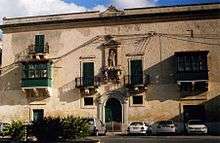
The area in front of the new parish church, which lay between the two old cores, was built up immediately after construction works began on the church. This land, known as Gwiedi, includes a number of palaces, chapels and large houses. Gregorio Bonnici's palace, Aedes Danielis, stands to this day on the main thoroughfare to the parish church. Grandmaster Perellos built a summer palace in the narrow streets of Gwiedi, as a residence for the feast of Saint Gregory.
In 1797, Grandmaster Ferdinand von Hompesch zu Bolheim was invited by the parishioners of Żejtun for the feast of St Catherine.[37] After the feast, Don Giacomo Michele Tortella, in the name of the clergy of Żejtun and the villagers, petitioned the Grandmaster to raise the village of Żejtun to the status of a city, on grounds of the town's large size, its established commercial interests and military contribution.[38] The petition was received, and on December 30, 1797, Grandmaster Hompesch recognised Żejtun as a city, granting it the title Ċittà Beland, this being his mother's maiden name.[n 4]
During the French Blockade, Żejtun was garrisoned by Maltese irregulars and British elements. The Maltese built a number of batteries to protect the city.[39] By the end of December 1799, the bulk of the 30th (Cambridgeshire) Regiment of Foot was stationed in the city, with advanced posts at Żabbar, and San Rocco Battery close to the coast.[40] Four buildings in Żejtun – the old church of St. Gregory, a villa belonging to Bishop Vincenzo Labini, and two villas belonging to Count Agostino Formosa de Fremaux (Palazzo Fremaux and Villa Arrigo) – were used as hospitals for invalids in the insurgency against the French.[41][42] Captain Alexander Ball, stayed at Żejtun on January 15, 1799, in order to meet with the leader of a group of irregulars, Vincenzo Borg "Brared". The meeting was not held due to the latter’s ill health.[43] In recognition of the villagers’ participation in the revolt against the French, a garden was built in 1802 by Alexander Ball, then British High Commissioner, as a gift to the leading representative of Żejtun, Ġuzè Abela. The garden, named Ġnien il-Kmand, served for administrative and embellishment purposes.[44]
Gallery
 Ġnien il-Kmand, known as Luqa Briffa Gardens
Ġnien il-Kmand, known as Luqa Briffa Gardens Palazzo Aedes Danielis
Palazzo Aedes Danielis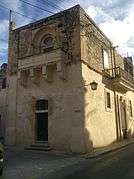 Vendome Tower, now a private property
Vendome Tower, now a private property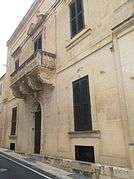 Casa Perellos, hunting lodge of Grand Master Perellos[45]
Casa Perellos, hunting lodge of Grand Master Perellos[45]
Late modern and contemporary

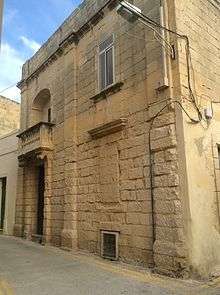
At the beginning of the 19th century, Żejtun was a major contributor to the islands' agrarian economy. Many of the Maltese merchants and traders hailed from the city.[46] Żejtun had the largest amount of arable land devoted to food production on the island, amounting to 8,585 acres (3,474 ha), or 15.1% of total land under cultivation.[47] Żejtun was the cotton producing centre of the islands, producing 10,312 cwt (hundredweights) of cotton, or 20.8% of the total production in 1836.[48] Such was the importance of the town for commerce, that a local merchant owned a single deck polacre, named Zeitun.[49]
As Malta's economy shifted to the servicing of the Royal Navy, much of the islands' commercial activity moved to the fortified cities around the harbour, with the importance of Żejtun declining gradually over time. Żejtun was linked with a main aqueduct providing water from Fawwara. The project was commissioned by Governor Henry F. Bouviere, and began providing water in 1845.[50] Twenty years later, in 1865, a cholera outbreak led to 84 deaths in the city, out of a total population of 5491. These were concentrated in the highest part town, near a windmill in the "upper casal, or el rahal ta' fuk." [51] As Żejtun continued to develop, the British colonial administration built a police-station and a public school, the latter finished in 1908.
A year later, in 1909, the Daughters of the Sacred Heart set up a children's home in the town.[52] In 1913, Josephine Curmi established a home for girls in Żejtun, which was eventually transferred to its current premises in 1925 - the Jesus of Nazareth Home. The charitable institute was placed under the care and direction of the Missionaries of Jesus of Nazareth.[52]
In the 1930s, the Żejtun parish minted 6000 aluminium token coins inscribed Zeitun to use as change when renting a chair in church during religious functions. The locals began to use the tokens as currency, until they were banned by the authorities. The tokens were collected back and stored in the parish treasury, and were forgotten. They were rediscovered in 2011,[53] and the parish began to sell them to fund restoration of the church's chandeliers. They have since become collectors' items.[54]
Part of Żejtun's school served as a hospital in the Second World War, also housing the Dorsetshire Regiment. The number of victims from Żejtun during this war amounted to 113, with the city suffering a number of air-raid attacks due to its relative proximity with the dockyards. A marble plaque in the main square commemorates a particular air-raid on the city.[55]
After the war, a number of urbanisation projects were designed around Żejtun. These include housing estates in Ġebel San Martin, Ħal Tmin and Ta' Ganza. Home ownership schemes and the availability of housing plots led to increased urban sprawl and congestion. In the eighties, Żejtun was known for fervent political rivalry which culminated in 1987, with an infamous riot involving supporters of the Malta Labour Party and the Nationalist Party.[56] The incidents took place in the main road approaching the town, known as Tal-Barrani. Reconciliation and peace, however, prevailed.[57]
Government
| Historical population | ||
|---|---|---|
| Year | Pop. | ±% |
| 1667 | 1,222 | — |
| 1679 | 1,575 | +28.9% |
| 1687 | 1,607 | +2.0% |
| 1716 | 2,224 | +38.4% |
| 1720 | 2,375 | +6.8% |
| 1725 | 2,497 | +5.1% |
| 1730 | 2,643 | +5.8% |
| 1735 | 2,665 | +0.8% |
| 1740 | 2,989 | +12.2% |
| 1744 | 2,985 | −0.1% |
| 1779 | 3,610 | +20.9% |
| 1782 | 3,687 | +2.1% |
| 1797 | 4,665 | +26.5% |
| 1805 | 4,024 | −13.7% |
| 1833 | 5,250 | +30.5% |
| 1839 | 5,113 | −2.6% |
| 1851 | 5,188 | +1.5% |
| 1865 | 5,491 | +5.8% |
| 1890 | 6,720 | +22.4% |
| 1931 | 8,731 | +29.9% |
| 1948 | 11,980 | +37.2% |
| 1957 | 11,665 | −2.6% |
| 1967 | 10,440 | −10.5% |
| 1985 | 11,321 | +8.4% |
| 1993 | 12,164 | +7.4% |
| 1994 | 11,326 | −6.9% |
| 1995 | 11,314 | −0.1% |
| 1996 | 11,379 | +0.6% |
| 1997 | 11,519 | +1.2% |
| 1998 | 11,722 | +1.8% |
| 1999 | 11,649 | −0.6% |
| 2000 | 11,331 | −2.7% |
| 2001 | 11,841 | +4.5% |
| 2002 | 11,793 | −0.4% |
| 2003 | 11,810 | +0.1% |
| 2004 | 11,758 | −0.4% |
| 2005 | 11,713 | −0.4% |
| 2006 | 11,789 | +0.6% |
| 2007 | 11,777 | −0.1% |
| 2008 | 11,558 | −1.9% |
| 2009 | 11,388 | −1.5% |
| 2010 | 11,417 | +0.3% |
| 2011 | 11,368 | −0.4% |
| 2012 | 11,541 | +1.5% |
| 2013 | 11,521 | −0.2% |
| 2014 | 11,508 | −0.1% |
| Source: Status Animarum 1679 - 1833,[58] NSO 1931 - 2014[59] | ||
Local Council
The members of the current Local Council elected following the election held on March 9, 2013 are:
- Joe Attard B.A.(Hons), Mayor (PL)
- Maria Dolores Abela, Deputy Mayor (PL)
- Joan Agius, Councillor (PL)
- Claude C. Camilleri, Councillor (PL)
- Sean Chircop B.A. P.G.C.E., Councillor (PL)
- Joseph Hales, Councillor (PL)
- Stephania Fenech B.A.(Hons), Councillor (PL)
- Amanda Abela B.Comm., Councillor (PN)
- Raymond Caruana, Councillor (PN)
Following the amendments to the Local Councils Act of 2009, the term of the current local council was extended from three to four years. The current Executive Secretary to the Town Council is Anton Falzon.
Transport
The main bus route in Żejtun is number 84. Routes 81, 82, 119, 135, N81 and N82 also pass through the city.
- Route 81 is from Marsaxlokk to Valletta and vice versa.
- Route 82 is from Birżebbuġa to Valletta and vice versa, passes from Bir id-Deheb.
- Route 84 is from Żejtun to Valletta and vice versa.
- Route 85 is from Qajjenza to Valletta and vice versa.
- Route 86 is from Qajjenza to Valletta and vice versa, passes from Bir id-Deheb (on Sundays only).
- Route 135 is from the Malta International Airport to Marsaskala and vice versa.
- Route 119 is from Birżebbuġa to Marsaskala and vice versa, passes from San Girgor.
- Route 206 is from Delimara to Mater Dei Hospital and vice versa.
- Route 210 is from Birżebbuġa to Mater Dei Hospital and vice versa.
- Route X5 is from Valletta to Marsaskala and vice versa, passes from San Girgor.
- Route X7 is from Valletta to Birgu and vice versa, passes from Bir id-Deheb.
- Route N81 is from Paceville to Malta International Airport.
- Route N82 is from Paceville to Birżebbuġa.
- There was also route 124 from Bir id-Deheb to Marsaskala and vice versa, which was discontinued.
Education
Żejtun has a secondary school for girls, St Margaret's College, located close to Saint Gregory's Church. The primary school, consists of two primary schools, Żejtun Primary 'A' Dun Alwiġ Camilleri and Żejtun Primary 'B'. A kindergarten school and a church school, Theresa Nuzzo School, can also be found in Żejtun.
Culture
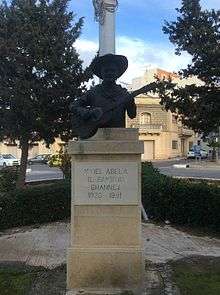
Dialect
The Żejtun accent long ago acquired the label of a dialect, and is similar to many accents of the south east of Malta. In Maltese this is termed as Żejtuni and by the speakers as Żejtewnij. The dialect is spoken by local inhabitants and those in neighbouring settlements around the city, such as Marsaxlokk.
Żejtun is considered the hub of Maltese folk singing, l-għana and the city has given Malta many of its most respected folk singers. These include Pawlu Seychell l-Għannej (1907–1992), Pawlu Degabriele il-Bies (1908–1980), Mikiel Abela il-Bambinu (1920–1991) and Frans Baldacchino il-Budaj (1943–2006). Famous contemporary Żejtun folksingers include Fredu Abela iż-Żejtuni and Mikiel Cutajar is-Superstar.
Religion

The most important event which takes place in the town during the year is the feast of St Catherine of Alexandria, which is celebrated in summer and not in the traditional date of November 25. On this day Żejtun's two rival musical bands, the Banda Beland and the Żejtun Band, perform in Gregorio Bonnici Square. The anthem dedicated to St. Catherine of Alexandria, played during the feast, was written by Emmanuele Palmier-Cecy, and was composed by Don Lorenzo Mifsud.
Żejtun boasts a large number of chapels such as the one dedicated to Saint Clement (San Klement), Our Lady of Good Counsel (Il-Madonna tal-Bon Kunsill), the chapel of Our Saviour (Tas-Salvatur) and the chapel of The Assumption (known as Santa Marija in Maltese), the chapel of the Holy Spirit (L-Ispirtu Santu) in Gwiedi, Saint Angelo (Sant' Anġlu), Saint Nicholas (San Niklaw), Our Lady of Mercy (Il-Madonna tal-Ħniena), Our Lady of Lourdes (Il-Madonna ta' Lourdes), and Saint Mary of Ħal Tmiem (Santa Marija ta' Ħal-Tmiem). Other chapels that in the recent past were part of the Żejtun parish are the chapel of Saint Anthony (Sant' Antnin) and the chapel of Saint Gaetan (San Gejtanu) in the limits of St Thomas Bay.
Gastronomy
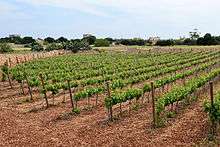
Each September, Żejtun hosts an annual festival celebrating the olive picking season and olive pressing for oil.[60] The aim of the festival is to highlight the intimate link between the city and olive trees, and the promotion of local olive cultivation. The activity starts with a defilé delivering the olive harvest, including the reading of a proclamation, or bandu, and the blessing of the olives prior to pressing.[61][62][63] The city is also known for its wine production, with the Marnisi wine producing estate.
Twin cities
The Żejtun Local Council has twinning arrangements with:
References
Notes
Notes
- ↑ (Italian) "Questa contrada (Żejtun) era molto amena per la gran quantità di oliveti che vi verdeggiano; onde trasse, ed ancora conserva, il nome di Zeitun, che significa olive; essendovi anche tradizione, che vi si facesse dell'olio in abbondanza."[5]
- ↑ (Italian) "Zejtun, con questo nome vi e’ all’oriente di Malta una terra grande, ricca e trafficante, che comprende ancora la terra detta Bisqallin, ed il villaggio Bisbut. Al tempo dei Saraceni vi dovevano essere degl’oliveti di cui conserva il vero nome."
- ↑ (Latin) Hoc opus fieri fecerunt Venerabilis Czullus dictu Baldu, et honorabiles Paulus Dalli, et Jacobus Bonnici Procuratores S. Catharinae de Zeitun - MCCCCLXXXXII - Ultimo Februarii X indictionis [25]
- ↑ (Latin) "Fiat p. perpetuite sub nomine Beland." [38]
Citations
- ↑ "Estimated Population by Locality 31st March, 2014". Government of Malta. 16 May 2014. Archived from the original on 21 June 2015.
- ↑ "Bulebel industrial zone". Malta Industrial Parks. Retrieved 25 August 2013.
- 1 2 3 "Santa Katerina Verġni u Martri magħrufa bħala ta' San Girgor". Diocese of Malta. Retrieved 25 August 2013.
- ↑ "New archipriest for Żejtun". Diocese of Malta. Retrieved 25 August 2013.
- ↑ Ciantar 1749, p. 317
- ↑ de Boisgelin de Kerdu 1805, p. 58
- ↑ Fiorini 2000, p. 499
- ↑ https://books.google.com.mt/books?id=krRTAAAAcAAJ&pg=PA106&lpg=PA106&dq=torri+hal+tmin&source=bl&ots=vRKZ8SPUFx&sig=dfUlJf3SdapALB_OCUp5U9Q4khg&hl=en&sa=X&ved=0ahUKEwjct478wsPMAhWOhRoKHY8WDEMQ6AEIIDAD#v=onepage&q=torri%20hal%20tmin&f=false p. 106.
- ↑ Ordnance Survey Sheets 1912/14, pp. 108–109
- ↑ Ordnance Survey Sheets 1912/14, pp. 121–122
- ↑ Bonanno 2005, p. 83
- 1 2 "The Żejtun Roman Villa: past and present excavations of a multi-period site". Wirt iż-Żejtun. Retrieved 25 August 2013.
- ↑ Bruno 2009, p. 42
- ↑ Bruno 2009, p. 120
- ↑ "The early Christian remains at Tas-Silġ and San Pawl Milqi, Malta, a reconsideration of the archaeological evidence" (PDF). Melita Historica. Retrieved 25 August 2013.
- ↑ "What happened in Malta after AD 870?". The Times of Malta. Retrieved 25 August 2013.
- 1 2 Wettinger 2000, p. 385
- ↑ "The development and spreading of devotion towards St. Catherine in Europe and Malta". Parish of Żurrieq. Retrieved 25 August 2013.
- 1 2 Ferris 1866, p. 367
- 1 2 3 "Twinning". Żejtun Local Council. Retrieved 22 July 2014.
- ↑ "Italian townsfolk look for lost ancestors... in Żejtun". The Times of Malta. Retrieved 25 August 2013.
- ↑ "Ezio Ciciotti accoglie Joseph Attard, sindaco di Zejtun, Comune di Malta". Comune di Celano. Retrieved 25 August 2013.
- ↑ Dalli 1993, pp. 1–12
- ↑ Mdina, Cathedral Archives 1494, p. Ms. 34, f.110 v.(1494)
- ↑ Abela 1647, pp. 364–365
- ↑ "St. Catherine's Medieval Church (aka St. Gregory's Church) - Virtual Tour". maltain360.com. Retrieved 25 August 2013.
- 1 2 3 4 Badger 1838, pp. 100–101
- 1 2 "Hundreds celebrate San Girgor at Marsaxlokk". The Times of Malta. Retrieved 25 August 2013.
- ↑ Vv Aa. 1955, p. 155
- ↑ Ciantar 1772, pp. 316–317
- ↑ Ferris 1866, p. 368
- ↑ http://www.maltawide.eu/default.asp?view=8&pos=2221&fid=15195&pid=15195&bk=
- ↑ http://www.alphaholidaylettings.com/rental/Zejtun/12956
- ↑ Hoppen 1980, p. 109
- 1 2 Hoppen 1980, p. 110
- ↑ Borg 1967, p. 304
- ↑ Vella 1927, p. 88
- 1 2 Archives of the Order of Malta 1797, p. 209
- ↑ Spiteri, Stephen C. (May 2008). "Maltese 'siege' batteries of the blockade 1798–1800" (PDF). Arx – Online Journal of Military Architecture and Fortification (6): 29–30. Retrieved 24 June 2015.
- ↑ "A HISTORY OF THE BRITISH ARMY IN MALTA". Retrieved 25 August 2013.
- ↑ Baldacchino, Godfrey (2011). Extreme Heritage Management: The Practices and Policies of Densely Populated Islands. Berghahn Books. p. 66. ISBN 0857452606.
- ↑ Abela, Joe (June 1998). "Żmien il-Franċiżi – Il-Vilel ta' Agostino Formosa De Fremaux Fiż-Żejtun (1798–1800)" (PDF). Festa Santa Katarina V.M. – Żejtun (in Maltese): 31–32. Archived from the original (PDF) on 31 May 2016.
- ↑ Appeals 1811, p. 18
- ↑ "Giardini Luca Briffa (Ġnien tal-Kmand)". maltain360.com. Retrieved 25 August 2013.
- ↑ http://romeartlover.tripod.com/Malta13.html
- ↑ Markoe, Glenn (1997). Corsairing to commerce: Maltese merchants in XVIII century Spain. Malta University Publishers. p. 60. ISBN 9990945047. At Google Books.
- ↑ Martin 1838, p. 588
- ↑ Martin 1838, p. 589
- ↑ Lloyd's Register of British and Foreign Shipping (Firm) 1833
- ↑ Savona-Ventura, Charles (2016). Contemporary Medicine in Malta (1798-1979). Lulu.com. p. 84. ISBN 9781326648992.
- ↑ Ghio 1867, p. 36
- 1 2 Savona-Ventura, Charles (2016). Contemporary Medicine in Malta (1798-1979). Lulu.com. p. 189. ISBN 9781326648992.
- ↑ Carabott, Sarah (24 June 2015). "100-year-old coins to save chandeliers". The Times of Malta. Archived from the original on 24 June 2015.
- ↑ Vella, Fiona (24 May 2015). "Forbidden Żejtun Church currency re-emerges as a collectable coin". Little Rock. Retrieved 24 June 2015.
- ↑ "Places of interest". Żejtun Local Council. Retrieved 25 August 2013.
- ↑ "Warped Wikipedia entry on 1986 Tal-Barrani incident". The Times of Malta. Retrieved 25 August 2013.
- ↑ "Chapter 3, The Labour Party in perspective" (PDF). Michael Briguglio. Retrieved 25 August 2013.
- ↑ Fiorini 1983, p. 344
- ↑ "Population statistics 1993-2013". Archived from the original on 16 November 2013. Retrieved 14 July 2014.
- ↑ "Activity Details". Żejtun Local Council. Retrieved 25 August 2013.
- ↑ "Olive oil festival in Żejtun tonight". The Times of Malta. 11 October 2008. Retrieved 25 August 2013.
- ↑ "Olive festival in Żejtun today". The Times of Malta. 25 September 2011. Retrieved 25 August 2013.
- ↑ "Żejtun celebrates the olive-picking season". The Times of Malta. 23 September 2011. Retrieved 25 August 2013.
Bibliography
- Abela, Giovanni Francesco (1647). Della descrittione di Malta isola nel mare Siciliano con le sve antichita: ed altre notitie, libri quattro. Malta: P. Bonacota. pp. 364–365.
- Badger, George Percy (1838). Description of Malta and Gozo. England: M. Weiss. pp. 100–101.
- Bonanno, Anthony (2005). Malta: Phoenician, Punic, and Roman. Malta: Midsea books. p. 83. ISBN 9993270350.
- Borg, V. (1967). Fabio Chigi, Apostolic Delegate in Malta, 1634-1639. An edition of his official correspondence (with Francesco Barberini, Cardinal Nephew). Vatican: Biblioteca Apostolica Vaticana. p. 308.}
- Bruno, Brunella (2009). Roman and Byzantine Malta: Trade and Economy. Malta: Midsea Books. p. 42. ISBN 9993272450.
- Bruno, Brunella (2009). Roman and Byzantine Malta: Trade and Economy. Malta: Midsea Books. p. 120. ISBN 9993272450.
- Ciantar, G.A. (1772). Malta illustrata... accresciuta dal Cte G.A. Ciantar. Malta: Mallia. pp. 316–317.
- Dalli, Charles (1993). ‘Medieval Communal Organization in an Insular Context: Approaching the Maltese Universitas’, The Making and Unmaking of the Maltese Universitas (A Supplement of Heritage). Malta: Midsea. pp. 1–12.
- de Boisgelin de Kerdu, Pierre Marie Louis (1805). Ancient and modern Malta, as also, the history of the Knights of St. John of Jerusalem. p. 58.
- Ghio (1867). The cholera in Malta and Gozo in 1865. Malta. p. 36.
- Ferris, Achille (1866). Descrizione storica delle chiese di Malta e Gozo. Malta. p. 367.
- Fiorini, Stanley (2001). Documentary sources of Maltese history: Documents at the Vatican ; No. 1, Archivio Segreto Vaticano, Congregazione Vescovi e Regolari, Malta: Visita Apostolica n. 51, Mgr Petrus Dusina, 1575, Page 4, Issue 1. Malta: Malta University Press. p. 499. ISBN 9990945268.
- Fiorini, Stanley (1983). Status Animarum I : A unique source for 17th and 18th century Maltese demography. Malta: Melita Historica. p. 344.
- Hoppen, Alison (1980). The Fortification of Malta, 1530-1798 : The Impact on the Maltese. Malta: Hyphen. p. 109.
- Hoppen, Alison (1980). The Fortification of Malta, 1530-1798 : The Impact on the Maltese. Malta: Hyphen. p. 110.
- Lloyd's Register of British and Foreign Shipping (Firm) (1833). Lloyd's Register of British and Foreign Shipping. England: Cox and Wyman.
- Martin, Robert Montgomery (1838). Statistics of the Colonies of the British Empire from the Official Records of the Colonial Office. England: W.H. Allen and Company. p. 588.
- Martin, Robert Montgomery (1838). Statistics of the Colonies of the British Empire from the Official Records of the Colonial Office. England: W.H. Allen and Company. p. 589.
- Mdina Cathedral Archives (1494). Cathedral Archives. Malta. p. Ms. 34, f.110 v.(1494).
- Ordnance Survey Sheets (1912/14). Map of Malta: Sheets 108, 109, 121 and 122. London: OS War Office. Check date values in:
|date=(help) - Sovereign Military Order of Malta (1797). Archives of the Order of Malta. Malta. p. Ms. 623, f.209.
- Vassalli, Mikiel Anton (1796). Ktŷb yl klŷm Mâlti, 'mfysser byl-Latîn u byt-Taljân, sive, Liber dictionum Melitensium: hoc est Michaelis Antonii Vassalli lexicon Melitenese-Latino-Italum; cui post auctarium accedunt, appendix etymologica et comparativa, et duo indices vocum Latinarum ac Italicarum: Melitensibus numero. Rome: Apud Antonium Fulgonium. p. 671.
- Vella, E.B. (1927). Storja taż-Żejtun u Marsaxlokk. Malta: Empire Press. p. 88.
- Various (1811). The appeals of the nobility and people of Malta, to the justice, public faith, and policy, of the British government, for the fulfilment of the conditions upon which they gave up their island to the king, namely, their ancient rights, under a free constitution. Malta. p. 18.
- Vv., Aa. (1955). Communicaciones Y Conclusiones Del Iii Congreso Internacional de Genealogia Y Heraldica. 1955. Spain: Ediciones Hidalguia. p. 155.
- Wettinger, Godfrey (2000). Place-names of the Maltese Islands Ca. 1300-1800. Malta: PEG. p. 385. ISBN 9990992495.
